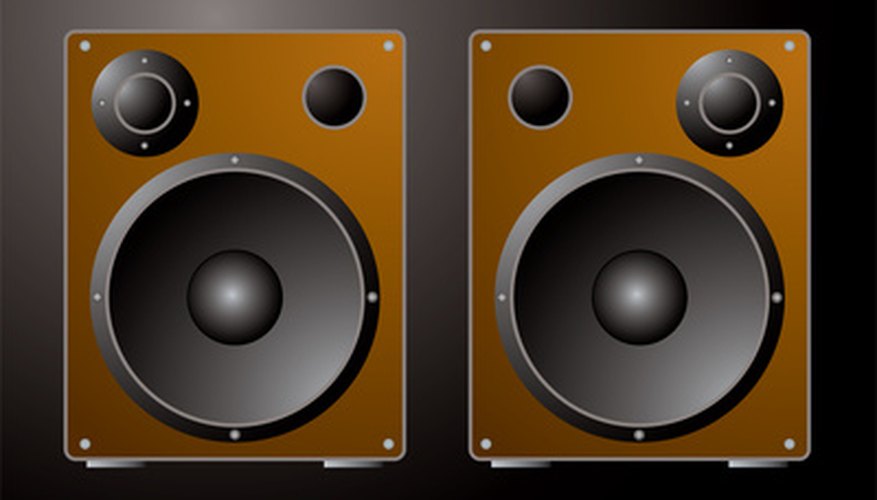The low-pitched whistle you hear when you blow across the top of a bottle is similar to what the port on a bass reflex speaker does. Bass reflex enclosures are vented to keep rear travelling sound waves from interfering with forward travelling waves. Since bass frequencies, and to a lesser degree midrange frequencies, are omnidirectional, most sound waves travel forward from your speakers, but some travel backwards then forwards when they bounce off the back of your enclosure. The port in bass reflex speakers tunes these reflected sound waves to a frequency that extends the low-end response.
Choose the tuning frequency. If you want the frequency response of your speakers to peak (be the loudest) at a frequency that's ideal for high volume playback, choose a tuning frequency of 45 Hz or higher. Your sound quality will suffer but your speakers will sound a lot louder. For better sound quality, you can extend and boost your bass and keep the rest of the frequencies flat by choosing a tuning frequency of 25 Hz or lower. If you want a little of both, good sound and high output, you can get it with a tuning frequency of 33 Hz.
- The low-pitched whistle you hear when you blow across the top of a bottle is similar to what the port on a bass reflex speaker does.
- For better sound quality, you can extend and boost your bass and keep the rest of the frequencies flat by choosing a tuning frequency of 25 Hz or lower.
Determine your port location. The formula used to determine port placement specifies that the distance between your ports and the speakers in your enclosure must be within a quarter wavelength of your tuning frequency. If your tuning frequency is 45 Hz, its wavelength is one tenth of that (approximately 5 feet) and one quarter of 5 is 1.25 feet. A lower frequency gives you less room to work with. Check this distance with your tape measure to find out where you can put the port. As long as you stay within the zone dictated by this formula, you can put your port anywhere on the enclosure without affecting your frequency response. Mark the centre of your port's location with an X (make sure it's in the same spot on both enclosures).
- Determine your port location.
- As long as you stay within the zone dictated by this formula, you can put your port anywhere on the enclosure without affecting your frequency response.
Determine your port diameter. Get your tuning frequency from Step 1 and look up your bass speaker size and Xmax (linear low frequency response) in your speaker documentation (if no Xmax number is provided, leave it at the default). Go to the Car Stereo link (See Resources 2) and enter these numbers in the corresponding fields of the "Minimum Usable Vent Diameter" calculator. If you'll be using more than one bass speaker, change the quantity in the calculator to reflect this. Choose "Yes" for bandpass enclosure (a box where the speaker is mounted on an internal baffle and sound exits the enclosure through a port) if this describes the speaker box you're building. Click the "Calculate Minimum" button to process the data and get the minimum recommended diameter for your port. Use your tape measure to adjust the pencil compass to this port diameter and draw a circle on your enclosures with the X's at the centre. Drill a hole on these circles as a starting point for your jigsaw and cut out the circles with it. Find or buy a PVC or cardboard tube with this diameter.
- Determine your port diameter.
- Go to the Car Stereo link (See Resources 2) and enter these numbers in the corresponding fields of the "Minimum Usable Vent Diameter" calculator.
Determine your port length. Measure the internal height, width and depth of your enclosure with your tape measure and multiply the results to calculate the enclosure volume. Get your tuning frequency from Step 1 and your port diameter from Step 2. Enter these values in the corresponding fields of the "Calculate Your Vent Length" calculator that appears directly below the "Minimum Usable Vent Diameter" calculator on the same web page. Leave the other choices at the defaults if you're using a single round port in your enclosures. Click on the "Calculate Length" button to process your data and get the recommended port length. Measure and mark your tubes to this length and cut them on your mitre saw. To finish the tuning, push your tubes into the holes you cut in Step 3 until they're flush with the front of your enclosures.
- Determine your port length.
- Leave the other choices at the defaults if you're using a single round port in your enclosures.
